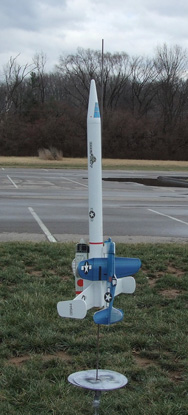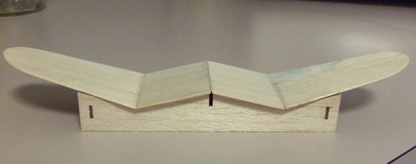| Construction Rating: | starstarstarstarstar_border |
| Flight Rating: | starstarstarstarstar |
| Overall Rating: | starstarstarstarstar_border |
| Manufacturer: | Squirrel Works  |
 Brief:
Brief:
Squirrel Works has followed up their very popular Red Baron glider with another cool historic-themed glider kit,
though this one includes TWO dueling gliders, a Corsair and a Zero. It's a reasonably simple kit to put together and
the gliders are minimal effort. So if you're looking for an easy diversion from the basic 3FNC rocket and a serious
"wow" factor, grab yourself a Dogfight kit.
Construction:
James Gartrell's review accurately described the components of the kit, so I'll skip on to construction notes. I
would point out that this is probably the first kit I've ever reviewed where I could not frame all the parts in a
single photo and even the decals took multiple shots to capture!
While the construction on this is fairly easy (probably no worse than a 2 on the skill scale), you will want to be very careful and organized throughout the project. There are lots of parts and three different sets of instructions, one for the rocket and one each for the gliders. James hopped back and forth, working all 3 simultaneously, but I decided to go for a more single-threaded approach.
I began with the booster which has a 15-step instruction sheet on legal paper with pretty good illustrations. The motor mount is straightforward, a 5/20 block, 18mm motor tube, metal hook and pair of 20/55 rings. This in turn goes inside the BT-55 body tube.
There are only two fins on this, plus 4 support braces which are all laser-cut balsa. Marking lines are done via wrap-around guide. Each of the main fins also gets a balsa fin tip attached, perpendicular to the main fins.
In addition to the regular launch lug which goes in a fin/root joint, there are two other launch lugs that must be carefully placed along the centerline between braces. These are used to secure the gliders during boost.
Booster construction wraps up with shock cord and chute. James pointed out the Kevlar® anchor, though I did not feel very comfortable anchoring an 8" length of Kevlar® using paper tri-fold, figuring eventually it would rip through the paper/glue. Instead, I swapped it out for a 15" length of 150# Kevlar® from my stash and anchored this to the forward centering ring on the motor mount. I then used the regular elastic included with the kit and tied it to the end of the Kevlar®.
 Next, I moved on to the gliders. Looking closely at
the two, I decided to start with the Zero, as it looked slightly simpler. I was impressed that with similar laser cut
pieces leading to potential mistakes in selecting parts, Don went the extra mile and actually had the plane's name
etched on each balsa sheet. I grabbed the "Zero" sheets and got to it.
Next, I moved on to the gliders. Looking closely at
the two, I decided to start with the Zero, as it looked slightly simpler. I was impressed that with similar laser cut
pieces leading to potential mistakes in selecting parts, Don went the extra mile and actually had the plane's name
etched on each balsa sheet. I grabbed the "Zero" sheets and got to it.
As James noted, there are mini jigs used for wing dihedral, which was very cool. I was also a bit worried about potentally gluing my wings to the jig, so dropped a piece of wax paper on the top of the jig before gluing my wing halves together then placing small weights on top of each half to hold them in place. I used a light Titebond wood glue for the gliders.
 After the wing halves are bonded, the assembly slides
through a slot in the balsa fuselage and is then glued in place, again using the jig for alignment. I thought the nose
weight approach on these was pretty neat. The fuselage has a hole cut out, and a pair of side plates that fit over it.
I glued one side plate in place, inserted a penny (provided), then glued the other side plate in place. I finished up
construction by tacking on a small dowel underneath, which slides into the launch lug on the booster.
After the wing halves are bonded, the assembly slides
through a slot in the balsa fuselage and is then glued in place, again using the jig for alignment. I thought the nose
weight approach on these was pretty neat. The fuselage has a hole cut out, and a pair of side plates that fit over it.
I glued one side plate in place, inserted a penny (provided), then glued the other side plate in place. I finished up
construction by tacking on a small dowel underneath, which slides into the launch lug on the booster.
 The Corsair construction is very similar to the Zero,
except that the wing forms a W shape with multiple dihedrals. I should also point out that the instruction for each
glider has specific tips for trimming, adding clay weight to get the CG to a very specific point that's different on
each glider. I hand-tossed mine in the back yard without weight and was very pleased with the flights. In fact, I
almost lost the Zero as is sailed through my neighbor's yard into the trees. Each of mine have CG's well aft of the
recommended locations, so I'm almost wondering if those measurements were before the use of the penny as nose weight. I
noticed James's review also indicated that he flew his "natural" without trim adjustments.
The Corsair construction is very similar to the Zero,
except that the wing forms a W shape with multiple dihedrals. I should also point out that the instruction for each
glider has specific tips for trimming, adding clay weight to get the CG to a very specific point that's different on
each glider. I hand-tossed mine in the back yard without weight and was very pleased with the flights. In fact, I
almost lost the Zero as is sailed through my neighbor's yard into the trees. Each of mine have CG's well aft of the
recommended locations, so I'm almost wondering if those measurements were before the use of the penny as nose weight. I
noticed James's review also indicated that he flew his "natural" without trim adjustments.
Finishing:
I want to say finishing is easy, basically just painting everything white but it is a lot of work and well worth the
effort. I would not spend any time (and add weight) filling balsa grains, but I did go ahead and fill the spirals on
the body tube and filled the grain on the nose cone with Fill N Finish.
The rocket got two coats of white primer followed by a single coat of Rustoleum gloss white. The gliders got single white primer coats and two coats of Krylon gloss white. In retrospect, I don't think the Zero needed any paint or at the very most a white primer coat, as it was entirely covered with decals. The Corsair, on the other hand, has a fading paint scheme that starts out through blue-based decals and is intended to melt into a base white paint coat.
 The decals do make the paint/finishing a
LOT easier, but there are pooploads of them. I probably spent as much time on the decals as I did on the construction.
I even had to take the water back to the microwave a couple times to reheat it.
The decals do make the paint/finishing a
LOT easier, but there are pooploads of them. I probably spent as much time on the decals as I did on the construction.
I even had to take the water back to the microwave a couple times to reheat it.
I found the sizing of some of the decals just a bit larger than the balsa parts they cover on the gliders, so had a little trimming and folding work. Because of this, I followed up with liberal coating of Micro-Sol decal setting solution (the red bottle stuff), which is designed to help "shrink" decals a bit and really lock them onto tricky contoured surfaces. Once the Micro-Sol had cured out for a couple hours, my decals looked like they were painted on.
Construction Rating: 4 out of 5
Flight:
For the first flight, I was down to the last day or two before the hit list deadline and facing 18-20 mphs winds both
days. On top of that, our club got booted from our large (1 square mile) field and so I was flying on a small
neighborhood field. With all this stacked up against me, I wimped out on the first flight with an A8-3, half the
recommended minimum impulse of B6-2.
The carrier and parasites managed to stay fairly straight up during the thrust portion, but at burnout got immediately pushed downwind by the stiff winds. I'd guess apogee was at best 50-60 feet, a pretty lame boost and certainly nothing I'd wind up losing. The ejection was just after the nose arced down, though both gliders separated cleanly.
Recovery:
Forget the trim intructions. These glided fantastically on their own with just the penny nose weights. I did add a
little clay under one wing on each hoping to get them to turn into each other, but in this wind there was no chance for
that.
The carrier descended fine under the bright red Mylar chute (18"), though got pulled long the ground a good 20 yards before I could catch up to it. During the drag, one of the fins broke loose and one of the gliders also cracked in half after landing and getting knocked around by the wind. Both were quickly and easily repaired with a little CA.
I would definitely not recommend the A8 for this, going with atleas the B6 recommended motor and I would think this would do well to maybe 300 feet or so on a C motor. If it weren't for the damage, I would have gone right back up the same day with a B.
Flight Rating: 5 out of 5
Summary:
For parasite gliders, this one is an excellent performer and fantastic appearance. In addition, there are plans to
release more gliders for variety. It's a fun build, well designed, and flies/glides very well.
CONs: very minor/picky, the trim instructions, if followed, would result in a very nose-heavy glide, probably crash landing. Decals, while beautiful, were a bit thin/fragile.
Oveall, I am quite pleased with this kit.
Overall Rating: 4 out of 5
Other Reviews
- Squirrel Works Dogfight By James Gartrell (October 13, 2008)
Brief: This newest kit from Squirrel Works is simply awesome! It's a BT-55 kit that comes with two fantastically designed parasite gliders fashioned to resemble the Corsair and Zero WWII fighter planes. The booster also bears resemblance to a WWII bomber, uses 18mm motors and recovers with a big 18" mylar chute. The face card in the kit is another true work of art, a signature ...
 |
 |
Flights
 |
 |
Sponsored Ads
 |
 |











D.M. (January 2, 2009)